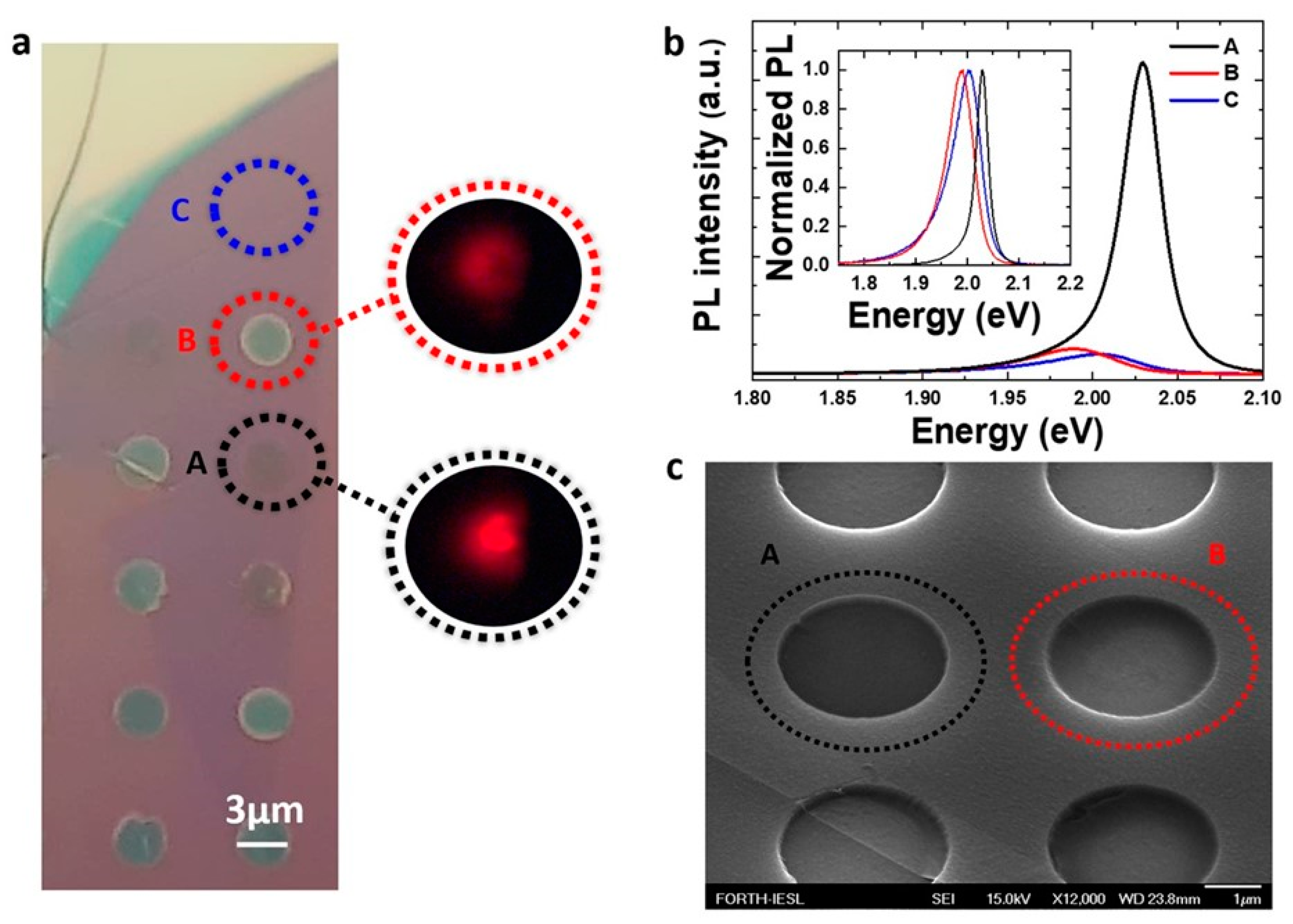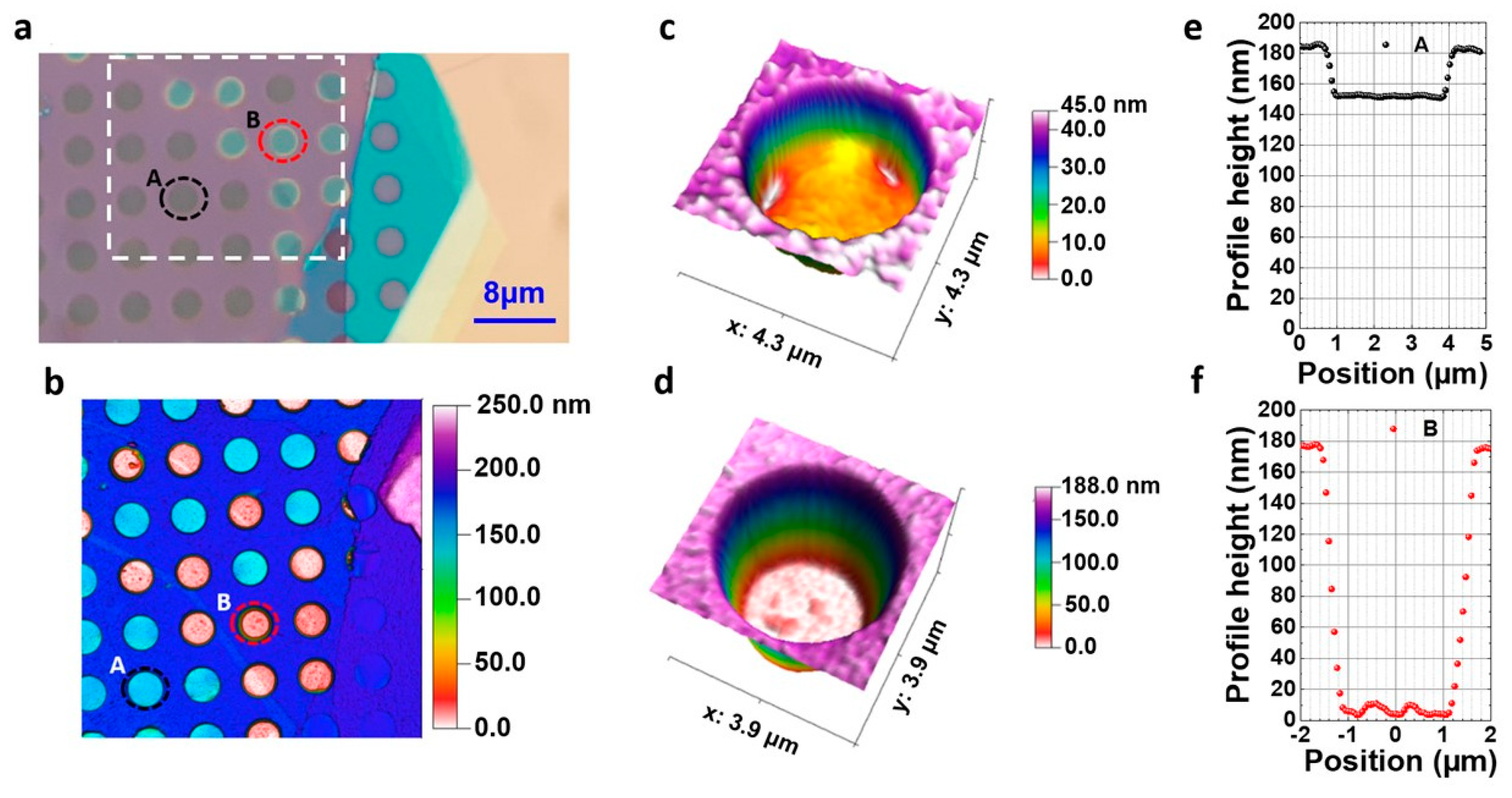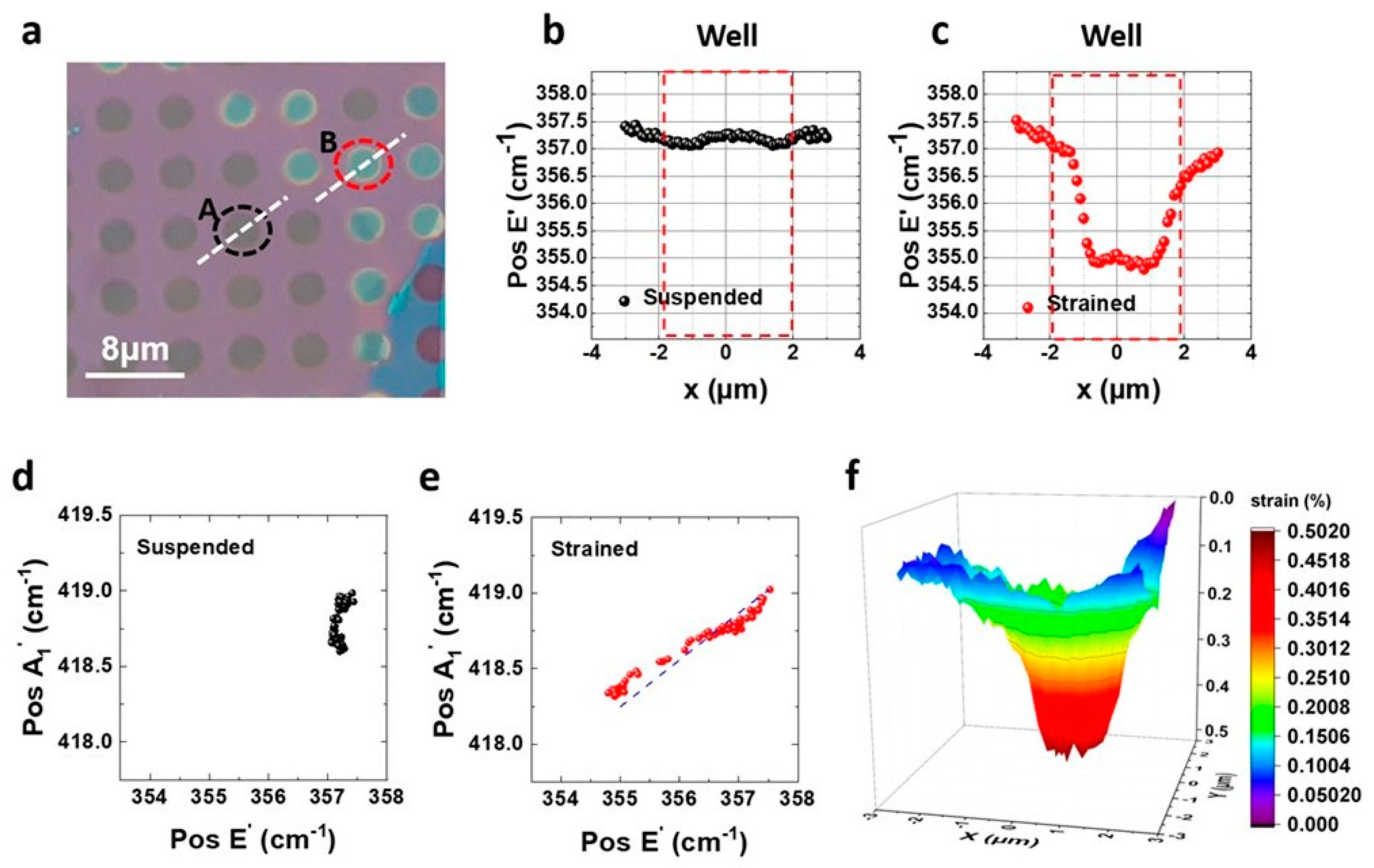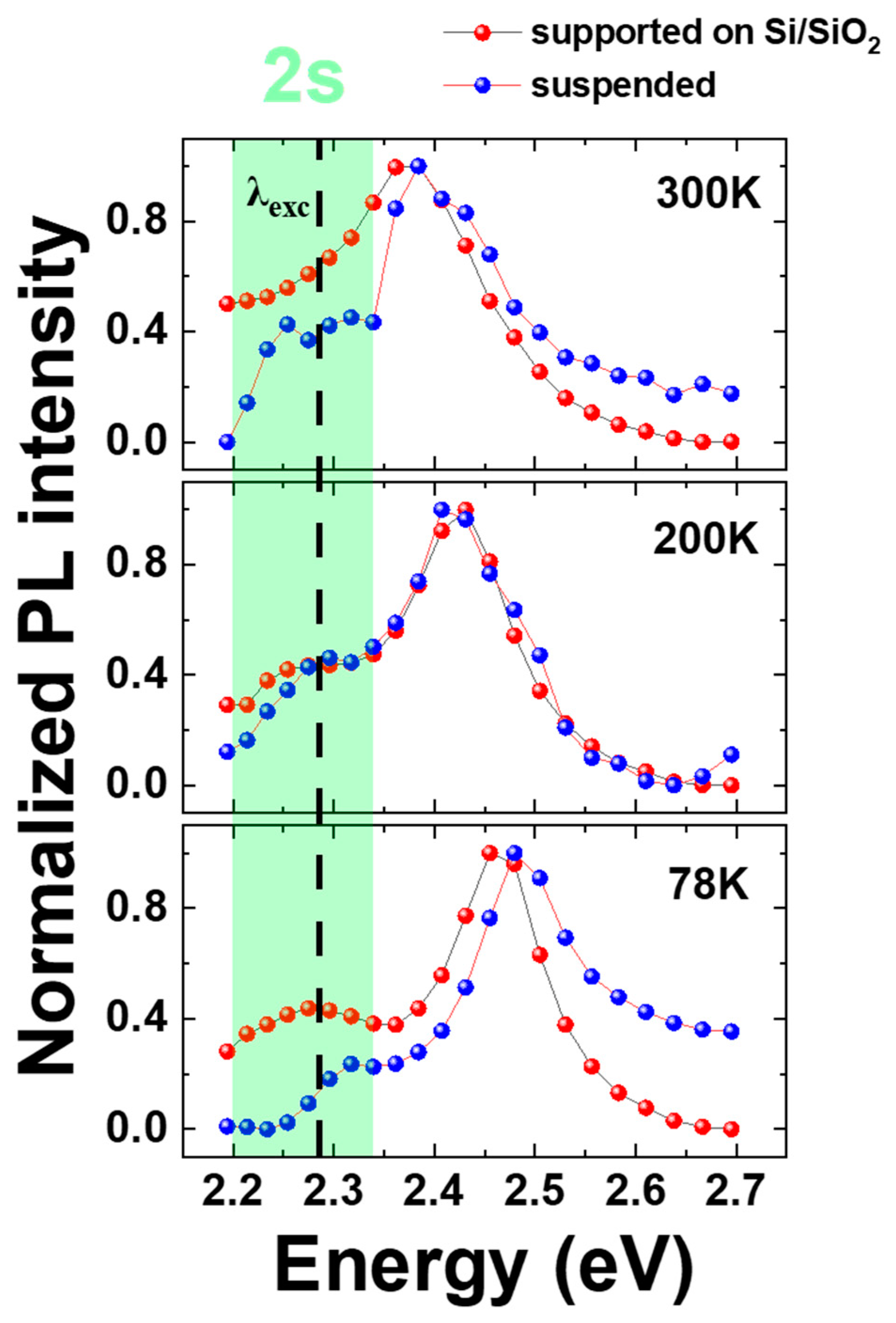Texture-Induced Strain in a WS2 Single Layer to Monitor Spin–Valley Polarization
Abstract
:1. Introduction
2. Materials and Methods
2.1. Substrate Patterning and Sample Preparation
2.2. Photoluminescence, Reflectivity, and Photoluminescence Excitation Spectroscopy
2.3. Atomic Force Microscopy (AFM)
2.4. Raman Spectroscopy
3. Results and Discussion
4. Conclusions
Supplementary Materials
Author Contributions
Funding
Data Availability Statement
Conflicts of Interest
References
- Wang, Q.H.; Kalantar-Zadeh, K.; Kis, A.; Coleman, J.N.; Strano, M.S. Electronics and optoelectronics of two-dimensional transition metal dichalcogenides. Nat. Nanotechnol. 2012, 7, 699–712. [Google Scholar] [CrossRef] [PubMed]
- Pospischil, A.; Mueller, T. Optoelectronic devices based on atomically thin transition metal dichalcogenides. Appl. Sci. 2016, 6, 78. [Google Scholar] [CrossRef]
- Schaibley, J.R.; Yu, H.; Clark, G.; Rivera, P.; Ross, J.S.; Seyler, K.L.; Yao, W.; Xu, X. Valleytronics in 2D Materials. Nat. Rev. Mater. 2016, 1, 16055. [Google Scholar] [CrossRef]
- Ahn, E.C. 2D materials for spintronic devices. Npj 2D Mater. Appl. 2020, 4, 17. [Google Scholar] [CrossRef]
- Mak, K.F.; Lee, C.; Hone, J.; Shan, J.; Heinz, T.F. Atomically thin MoS2: A new direct-gap semiconductor. Phys. Rev. Lett. 2010, 105, 136805. [Google Scholar] [CrossRef]
- Splendiani, A.; Sun, L.; Zhang, Y.; Li, T.; Kim, J.; Chim, C.-Y.Y.; Galli, G.; Wang, F. Emerging photoluminescence in monolayer MoS2. Nano Lett. 2010, 10, 1271–1275. [Google Scholar] [CrossRef]
- Mak, K.F.; He, K.; Shan, J.; Heinz, T.F. Control of valley polarization in monolayer MoS2 by optical helicity. Nat. Nanotechnol. 2012, 7, 494–498. [Google Scholar] [CrossRef]
- Zeng, H.; Dai, J.; Yao, W.; Xiao, D.; Cui, X. Valley Polarization in MoS2 Monolayers by Optical Pumping. Nat. Nanotechnol. 2012, 7, 490–493. [Google Scholar] [CrossRef]
- Cao, T.; Wang, G.; Han, W.; Ye, H.; Zhu, C.; Shi, J.; Niu, Q.; Tan, P.; Wang, E.; Liu, B.; et al. Valley-selective circular dichroism of monolayer molybdenum disulphide. Nat. Commun. 2012, 3, 885–887. [Google Scholar] [CrossRef]
- Xiao, D.; Liu, G.B.; Feng, W.; Xu, X.; Yao, W. Coupled spin and valley physics in monolayers of MoS2 and other group-VI dichalcogenides. Phys. Rev. Lett. 2012, 108, 1–5. [Google Scholar] [CrossRef]
- Hanbicki, A.T.; McCreary, K.M.; Kioseoglou, G.; Currie, M.; Hellberg, C.S.; Friedman, A.L.; Jonker, B.T. High room temperature optical polarization due to spin-valley coupling in monolayer WS2. AIP Adv. 2016, 6, 055804. [Google Scholar] [CrossRef]
- McCreary, K.M.; Hanbicki, A.T.; Singh, S.; Kawakami, R.K.; Jernigan, G.G.; Inhigami, M.; Ng, A.; Brintlingrer, T.H.; Stroud, R.M.; Jonker, B.T. The effect of preparation conditions on Raman and Photoluminescence of monolayer WS2. Sci. Rep. 2016, 6, 35154. [Google Scholar] [CrossRef]
- Lippert, S.; Schneider, L.M.; Renaud, D.; Kang, K.N.; Ajayi, O.; Kuhnert, J.; Halbich, M.U.; Abdulmunem, O.M.; Lin, X.; Hasson, K. Influence of the substrate material on the optical properties of tungsten diselenide monolayers. 2D Mater. 2017, 4, 025045. [Google Scholar] [CrossRef]
- Yu, Y.; Yu, Y.; Xu, C.; Cai, Y.Q.; Su, L.; Zhang, Y.; Zhang, Y.W.; Gundogdu, K.; Cao, L. Engineering Substrate Interactions for High Luminescence Efficiency of Transition-Metal Dichalcogenide Monolayers. Adv. Funct. Mater. 2016, 26, 4733–4739. [Google Scholar] [CrossRef]
- Wang, Z.; Dong, Z.; Gu, Y.; Chang, Y.H.; Zhang, L.; Li, L.J.; Zhao, W.; Eda, G.; Zhang, W.; Grinblat, G.; et al. Giant photoluminescence enhancement in tungsten-diselenide-gold plasmonic hybrid structures. Nat. Commun. 2016, 7, 11283. [Google Scholar] [CrossRef]
- Sortino, L.; Zotev, P.G.; Mignuzzi, S.; Cambiasso, J.; Schmidt, D.; Genco, A.; Aßmann, M.; Bayer, M.; Maier, S.A.; Sapienza, R.; et al. Enhanced light-matter interaction in an atomically thin semiconductor coupled with dielectric nano-antennas. Nat. Commun. 2019, 10, 5119. [Google Scholar] [CrossRef]
- Duong, N.M.H.; Xu, Z.Q.; Kianinia, M.; Su, R.; Liu, Z.; Kim, S.; Bradac, C.; Tran, T.T.; Wan, Y.; Li, L.J.; et al. Enhanced emission from WSe2 monolayers coupled to circular Bragg gratings. ACS Photonics 2018, 5, 3950–3955. [Google Scholar] [CrossRef]
- Branny, A.; Kumar, S.; Proux, R.; Gerardot, B.D. Deterministic strain-induced arrays of quantum emitters in a two-dimensional semiconductor. Nat. Commun. 2017, 8, 15053. [Google Scholar] [CrossRef]
- Palacios-Berraquero, C.; Kara, D.M.; Montblanch, A.R.P.; Barbone, M.; Latawiec, P.; Yoon, D.; Ott, A.K.; Loncar, M.; Ferrari, A.C.; Atatüre, M. Large-scale quantum-emitter arrays in atomically thin semiconductors. Nat. Commun. 2017, 8, 15093. [Google Scholar] [CrossRef]
- Deng, S.; Sumant, A.V.; Berry, V. Strain engineering in two-dimensional nanomaterials beyond graphene. Nano Today 2018, 22, 14–35. [Google Scholar] [CrossRef]
- Peng, Z.; Chen, X.; Fan, Y.; Srolovitz, D.J.; Lei, D. Strain engineering of 2D semiconductors and graphene: From strain fields to band-structure tuning and photonic applications. Light Sci. Appl. 2020, 9, 190. [Google Scholar] [CrossRef]
- Jiang, D.; Liu, Z.; Xiao, Z.; Qian, Z.; Sun, Y.; Zeng, Z.; Wang, R. Flexible electronics based on 2D transition metal dichalcogenides. J. Mater. Chem. A 2022, 10, 89–121. [Google Scholar] [CrossRef]
- Wang, Y.; Cong, C.; Yang, W.; Shang, J.; Peimyoo, N.; Chen, Y.; Kang, J.; Wang, J.; Huang, W.; Yu, T. Strain-induced direct–indirect bandgap transition and phonon modulation in monolayer WS2. Nano Res. 2015, 8, 2562–2572. [Google Scholar] [CrossRef]
- Frisenda, R.; Drüppel, M.; Schmidt, R.; Michaelis de Vasconcellos, S.; Perez de Lara, D.; Bratschitsch, R.; Rohlfing, M.; Castellanos-Gomez, A. Biaxial strain tuning of the optical properties of single-layer transition metal dichalcogenides. Npj 2D Mater. Appl. 2017, 1, 10. [Google Scholar] [CrossRef]
- Zhu, C.R.; Wang, G.; Liu, B.L.; Marie, X.; Qiao, X.F.; Zhang, X.; Wu, X.X.; Fan, H.; Tan, P.H.; Amand, T.; et al. Strain tuning of optical emission energy and polarization in monolayer and bilayer MoS2. Phys. Rev. B—Condens. Matter Mater. Phys. 2013, 88, 121301. [Google Scholar] [CrossRef]
- Michail, A.; Anestopoulos, D.; Delikoukos, N.; Parthenios, J.; Grammatikopoulos, S.; Tsirkas, S.A.; Lathiotakis, N.N.; Frank, O.; Filintoglou, K.; Papagelis, K. Biaxial strain engineering of CVD and exfoliated single- and bi-layer MoS2 Crystals. 2D Mater. 2021, 8, 15023. [Google Scholar] [CrossRef]
- Michail, A.; Anestopoulos, D.; Delikoukos, N.; Grammatikopoulos, S.; Tsirkas, S.A.; Lathiotakis, N.N.; Frank, O.; Filintoglou, K.; Parthenios, J.; Papagelis, K. Tuning the photoluminescence and Raman response of single-layer WS2 crystals using biaxial strain. J. Phys. Chem. C 2023, 127, 3506–3515. [Google Scholar] [CrossRef]
- Harats, M.G.; Kirchhof, J.N.; Qiao, M.; Greben, K.; Bolotin, K.I. Dynamics and efficient conversion of excitons to trions in non-uniformly strained monolayer WS2. Nat. Photonics 2020, 14, 324–329. [Google Scholar] [CrossRef]
- Cadiz, F.; Courtade, E.; Robert, C.; Wang, G.; Shen, Y.; Cai, H.; Taniguchi, T.; Watanabe, K.; Carrere, H.; Lagarde, D.; et al. Excitonic linewidth approaching the homogeneous limit in MoS2-based van der Waals heterostructures. Phys. Rev. X 2017, 7, 021026. [Google Scholar] [CrossRef]
- Castellanos-Gomez, A.; Buscema, M.; Molenaar, R.; Singh, V.; Janssen, L.; Van Der Zant, H.S.J.; Steele, G.A. Deterministic transfer of two-dimensional materials by all-dry viscoelastic stamping. 2D Mater. 2014, 1, 011002. [Google Scholar] [CrossRef]
- Tripathi, M.; Paolicelli, G.; D’Addato, S.; Valeri, S. Controlled AFM detachments and movement of nanoparticles: Gold clusters on HOPG at different temperatures. Nanotechnology 2012, 23, 245706. [Google Scholar] [CrossRef] [PubMed]
- Berkdemir, A.; Gutierrez, H.R.; Botello-Mendez, A.R.; Perea-Lopez, N.; Elias, A.L.; Chia, C.I.; Wang, B.; Crespi, V.H.; Lopez-Urias, F.; Charlier, J.C.; et al. Identification of individual and few layers of WS2 using Raman spectroscopy. Sci. Rep. 2013, 3, 1755. [Google Scholar] [CrossRef]
- Michail, A.; Delikoukos, N.; Parthenios, J.; Galiotis, C.; Papagelis, K. Optical detection of strain and doping inhomogeneities in single layer MoS2. Appl. Phys. Lett. 2016, 108, 173102. [Google Scholar] [CrossRef]
- Kioseoglou, G.; Hanbicki, A.T.; Currie, M.; Friedman, A.L.; Gunlycke, D.; Jonker, B.T. Valley polarization and intervalley scattering in monolayer MoS2. Appl. Phys. Lett. 2012, 101, 221907. [Google Scholar] [CrossRef]
- McCreary, K.M.; Currie, M.; Hanbicki, A.T.; Chuang, H.J.; Jonker, B.T. Understanding variations in circularly polarized photoluminescence in monolayer transition metal dichalcogenides. ACS Nano 2017, 11, 7988–7994. [Google Scholar] [CrossRef] [PubMed]
- Robert, C.; Semina, M.A.; Cadiz, F.; Manca, M.; Courtade, E.; Taniguchi, T.; Watanabe, K.; Cai, H.; Tongay, S.; Lassagne, B.; et al. Optical spectroscopy of excited exciton states in MoS2 monolayers in van der Waals heterostructures. Phys. Rev. Mater. 2018, 2, 011001. [Google Scholar] [CrossRef]
- Wang, G.; Glazov, M.; Robert, C.; Amand, T.; Marie, X.; Urbaszek, B. Double Resonant Raman Scattering and Valley Coherence Generation in Monolayer WSe2. Phys. Rev. Lett. 2015, 115, 117401. [Google Scholar] [CrossRef]
- Zhang, X.; Qiao, X.F.; Shi, W.; Wu, J.B.; Jiang, D.S.; Tan, P.H. Phonon and Raman Scattering of Two-Dimensional Transition Metal Dichalcogenides from Monolayer, Multilayer to Bulk Material. Chem. Soc. Rev. 2015, 44, 2757–2785. [Google Scholar] [CrossRef]
- Zhao, W.; Ghorannevis, Z.; Amara, K.K.; Pang, J.R.; Toh, M.; Zhang, X.; Kloc, C.; Tan, P.H.; Eda, G. Lattice Dynamics in Mono- and Few-Layer Sheets of WS2 and WSe2. Nanoscale 2013, 5, 9677. [Google Scholar] [CrossRef]







Disclaimer/Publisher’s Note: The statements, opinions and data contained in all publications are solely those of the individual author(s) and contributor(s) and not of MDPI and/or the editor(s). MDPI and/or the editor(s) disclaim responsibility for any injury to people or property resulting from any ideas, methods, instructions or products referred to in the content. |
© 2024 by the authors. Licensee MDPI, Basel, Switzerland. This article is an open access article distributed under the terms and conditions of the Creative Commons Attribution (CC BY) license (https://creativecommons.org/licenses/by/4.0/).
Share and Cite
Kourmoulakis, G.; Michail, A.; Anestopoulos, D.; Christodoulides, J.A.; Tripathi, M.; Dalton, A.Β.; Parthenios, J.; Papagelis, K.; Stratakis, E.; Kioseoglou, G. Texture-Induced Strain in a WS2 Single Layer to Monitor Spin–Valley Polarization. Nanomaterials 2024, 14, 1437. https://doi.org/10.3390/nano14171437
Kourmoulakis G, Michail A, Anestopoulos D, Christodoulides JA, Tripathi M, Dalton AΒ, Parthenios J, Papagelis K, Stratakis E, Kioseoglou G. Texture-Induced Strain in a WS2 Single Layer to Monitor Spin–Valley Polarization. Nanomaterials. 2024; 14(17):1437. https://doi.org/10.3390/nano14171437
Chicago/Turabian StyleKourmoulakis, George, Antonios Michail, Dimitris Anestopoulos, Joseph A. Christodoulides, Manoj Tripathi, Alan Β. Dalton, John Parthenios, Konstantinos Papagelis, Emmanuel Stratakis, and George Kioseoglou. 2024. "Texture-Induced Strain in a WS2 Single Layer to Monitor Spin–Valley Polarization" Nanomaterials 14, no. 17: 1437. https://doi.org/10.3390/nano14171437
APA StyleKourmoulakis, G., Michail, A., Anestopoulos, D., Christodoulides, J. A., Tripathi, M., Dalton, A. Β., Parthenios, J., Papagelis, K., Stratakis, E., & Kioseoglou, G. (2024). Texture-Induced Strain in a WS2 Single Layer to Monitor Spin–Valley Polarization. Nanomaterials, 14(17), 1437. https://doi.org/10.3390/nano14171437












